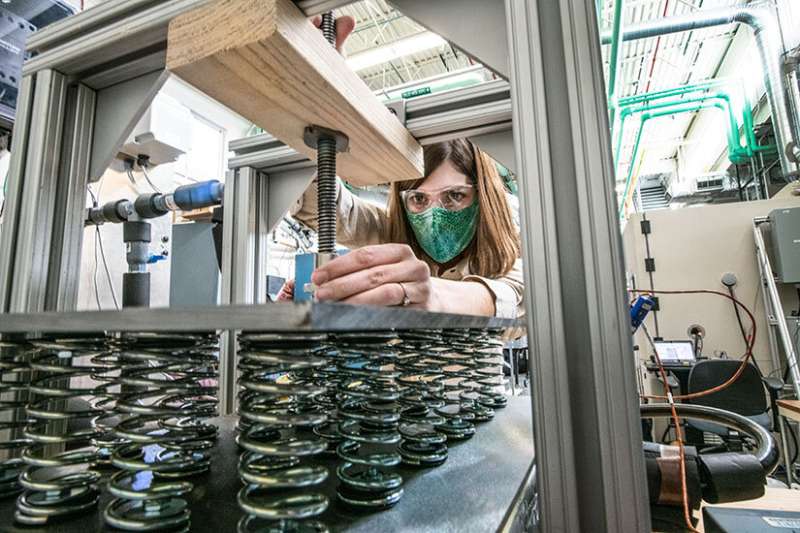NREL heats up thermal energy storage with new solution meant to ease grid stress, ultimately improving energy efficiency

Scientists from the National Renewable Energy Laboratory (NREL) have developed a simple way to better evaluate the potential of novel materials to store or release heat on demand in your home, office, or other building in a way that more efficiently manages the building's energy use.
Their work, featured in Nature Energy, proposes a new design method that could make the process of heating and cooling buildings more manageable, less expensive, more efficient, and better prepared to flexibly manage power from renewable energy sources that do not always deliver energy when it is most needed.
The paper, "Rate Capability and Ragone Plots for Phase Change Thermal Energy Storage," was authored by NREL's Jason Woods, along with co-authors Allison Mahvi, Anurag Goyal, Eric Kozubal, Wale Odukomaiya, and Roderick Jackson. The paper describes a new way of optimizing thermal storage devices that mirrors an idea used for batteries, helping to inform what new thermal storage materials are needed for buildings and how the devices should be designed with these materials.
Thermal energy storage allows buildings to function like a huge battery by storing thermal energy in novel materials until it can be used later. One example is a heat pump. While electricity is needed initially to create and store the heat, the heat is used later without using additional electricity.
In another example, some materials have the ability to change phases, like ice that can transition from a solid to a liquid. As the ice melts, it absorbs energy from and cools a working fluid, which can then be used to cool a building space. Because phase change occurs at a nearly constant temperature, useful energy can be provided or stored for a longer period at a steady temperature. Thermal energy storage is typically very "round trip" energy efficient.
The authors discovered that a Ragone plot, often used to characterize batteries, also works well to describe the potential effectiveness of various thermal storage device candidates. A Ragone plot shows the tradeoff between how much energy a device can store and its discharge power, or how quickly the device can release energy. This foundational approach makes comparisons between different thermal storage materials or device improvements easier to evaluate. It serves as a starting point for defining targets and is a useful design tool to develop new thermal storage materials and devices that can serve as novel, alternative energy storage options.
"This Ragone framework ensures cost-effective design of thermal storage materials and devices depending on the power and energy requirements of a particular application," said Jason Woods, a senior research engineer at NREL and lead author of the newly published paper.
Mahvi, a postdoctoral researcher at NREL, said another advantage is enabling technologies that can mitigate blackouts on the grid. "Most of peak electricity demand—especially in the summer when you might see blackouts—is driven by air conditioning. If you can move that demand to some other time of the day, you can help alleviate the strain on the grid, keeping the grid operational, but also keeping people indoors comfortable."
"Thermal energy storage systems will need to become more flexible and adaptable with the addition of onsite power generation, electric vehicle charging, and the combination of thermal storage with batteries," Woods said. "Part of this flexibility requires higher power—but this higher power comes at a cost of available energy, as this publication highlights."
The way in which the thermal energy storage is used will impact its performance. Scientists need to consider questions about how stored energy can best be used to keep building occupants comfortable, or for different applications like maintaining electronic equipment at a safe temperature.
"Which one works best for me and my application will depend on what the requirements are. How much do I need to store, and how fast do I need to discharge it?" Mahvi said. "This framework will allow us to optimize thermal storage systems from the material to the component scale to increase the power density while still accessing as much of the available capacity as possible. This will result in more efficient devices that can be used for a wide range of applications."
The researchers developed a computer model to understand the various design tradeoffs with these thermal storage devices, including ones that require high power (release the energy quickly) and low power (release the energy slowly). They also built a prototype phase change thermal storage device, illustrating this power-energy tradeoff in practice.
More information: Jason Woods et al. Rate capability and Ragone plots for phase change thermal energy storage, Nature Energy (2021). DOI: 10.1038/s41560-021-00778-w















